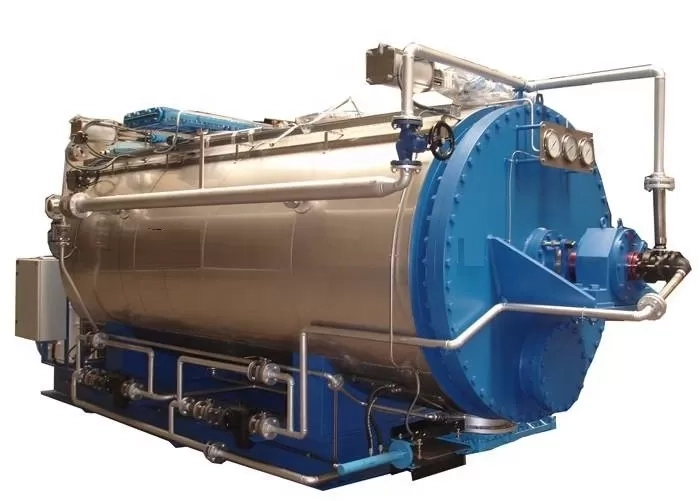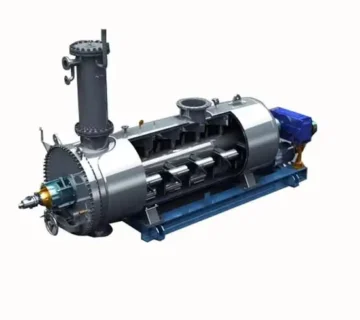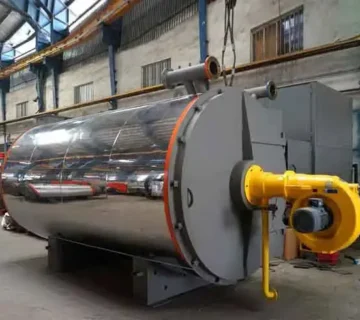In various industries such as food, agriculture, livestock, and slaughterhouses, a significant amount of waste is generated. The recycling and processing of this waste are crucial, and cookers play a key role in separating valuable materials like fat, proteins, and other components. Selecting the appropriate cooker capacity can optimize energy consumption, improve efficiency, and reduce costs.
2. Various Industries and Their Waste Cooker Needs
a) Slaughterhouse Industries
Slaughterhouses produce large amounts of animal waste, including bones, fats, skin, and meat residues. These industries rely on cookers to prevent waste and produce valuable byproducts such as animal feed.
- Required cooker capacity: Small slaughterhouses typically use cookers with capacities of 3 to 6 tons, while large slaughterhouses require cookers of 10 tons or more.
- Steam requirements: Large slaughterhouses need steam with a flow rate of 2000 to 3000 kg/h.

b) Fish and Seafood Processing Industries
These industries produce significant waste such as fish skins, bones, and leftovers. Cookers help turn this waste into valuable byproducts like fish oil and fish meal.
- Required cooker capacity: Depending on production volume, seafood processing industries use cookers with a capacity of 2 to 5 tons.
- Steam requirements: Steam flow rates of 1000 to 2000 kg/h are suitable for these industries.
c) Animal Feed and Poultry Industries
These industries utilize slaughterhouse waste and other recycled materials to produce bone meal and animal protein. Cookers facilitate fast and efficient processing.
- Required cooker capacity: Medium-sized cookers with a capacity of 4 to 8 tons are commonly used.
- Steam requirements: Steam flow rates of 1500 to 2500 kg/h are recommended.
d) Agricultural and Plant Waste Recycling Industries
In agriculture, plant waste and residues are used to produce compost or animal feed. Cookers help turn this waste into usable products.
- Required cooker capacity: For agricultural industries, cookers with a capacity of 2 to 5 tons are suitable.
- Steam requirements: Cookers with steam flow rates of 1000 to 1500 kg/h are generally sufficient.
e) Leather and Skin Processing Industries
Leather and skin industries use cookers to separate excess materials from animal skins to produce raw leather.
- Required cooker capacity: These industries typically use small to medium-sized cookers with a capacity of 1 to 4 tons.
- Steam requirements: Steam flow rates of 500 to 1200 kg/h are suitable.
3. Steam Calculation for Each Cooker Capacity
The following table provides a guideline for steam requirements based on cooker capacity:
| Cooker Capacity (Tons) | Required Steam (kg/h) |
|---|---|
| 1 to 3 tons | 500 to 1000 |
| 3 to 6 tons | 1000 to 1500 |
| 6 to 10 tons | 1500 to 3000 |
| Over 10 tons | More than 3000 |
4. Choosing the Right Cooker Based on Fuel Type
The type of fuel used in steam boilers impacts the efficiency and steam output of the cooker. The most common fuels are:
- Natural Gas: Natural gas boilers offer higher efficiency and stable steam production.
- Diesel: Diesel fuel can also be used but may have higher operating costs.
- Electricity: Electric boilers are suitable for small-scale industries with lower steam needs.
5. FAQ Section
Q1: How do I determine the right cooker capacity for my plant?
A: First, calculate the daily volume of waste and the required cooking process. Then, select a cooker capacity and steam output that meets those needs.
Q2: Does higher steam output mean better performance?
A: Not necessarily. Excessive steam may lead to energy waste. It’s best to choose the cooker’s capacity and steam output based on actual needs.
Q3: What factors help reduce steam consumption?
A: Optimizing insulation, using efficient steam boilers, and reducing cooking time can help minimize steam usage.
Q4: Does the type of waste affect the choice of cooker capacity?
A: Yes, different types of waste require different cooking times and temperatures, so cooker capacity should be selected accordingly.

6. Conclusion
Waste cookers play a vital role in industries such as slaughterhouses, fish processing, animal feed, and agriculture. Selecting the right cooker capacity based on waste type, production volume, and fuel type can enhance efficiency and reduce costs. Ultimately, choosing an appropriate capacity and steam rate will maximize process productivity.




